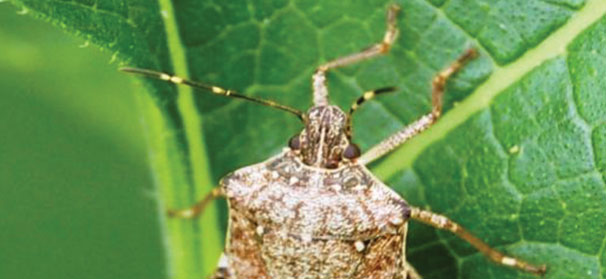

Nov 18, 2011Stink bug continues to bedevil growers
Brown Marmorated Stink Bug (BMSB) has dramatically impacted the fruit and vegetable industry, and as it continues to spread, so do fears that there is nothing that can stop it.
BMSB is native to Asia, and managed to make its way to North America via shipping containers and other import vessels. Being an adept hitchhiker, it found a home in the mid-Atlantic region and quickly spread out from there.
In 1999, a BMSB specimen was found in a Rutgers University trap in Milford, N.J. Since that time, specimens have been identified in at least 36 states, primarily in the mid-Atlantic region but with additional populations found in Oregon and southern California. Midwestern populations of BMSB were found in Ohio in 2007, Illinois in 2009 and Michigan in 2010. As with other invasive species, the distribution is likely spread wider than reported.
According to a report written by Jerry Brust, an IPM vegetable specialist with the University of Maryland, it has been found feeding on sweet corn, tomato and pepper. The damage to corn is lack of kernel development. Tomatoes and peppers show distortions in the fruit and cloudy spots.
There is hope, however. In a report recently published by Rutgers University and USDA, some headway in the fight against BMSB was reported. According to the report, the USDA team, under the leadership of entomologist Tracy Leskey, has made some discoveries about BMSB. They have found that populations of BMSB move from the wild into cultivated crops, creating a re-infestation issue – making BMSB a season-long problem, unlike some other pests.
According to the report, the greatest efficacy has been observed when BMSB adults come into direct contact with wet spray materials. It is highly likely that only small portions of the adult population come into direct contact with the wet spray deposits. Further adding to the troubles are the findings that pesticides labeled for native stink bugs are mostly ineffective against BMSB.
One other trait of BMSB mentioned in the report is especially troubling to Leskey. The bugs exhibit avoidance behavior that shows they have the capacity to escape sprays and other treatments.
The report said Lannate demonstrates moderate to good efficacy in killing BMSB. Organophosphates have shown some potential, as well. One pyrethroid, bifenthrin, has also worked. Neonicotinoids showed significant insect recovery and are not recommended in the report.
The bug doesn’t seem to be spreading in at least one state. Jim Labonte, an entomologist with the Oregon Department of Agriculture, said it seems to have stopped spreading.
“As far as I know, no new counties since last year,” he said. “We tried several BMSB traps, along with the lure, and got nothing.”
For more information on BMSB, Penn State University has information online.
By Derrek Sigler, Associate Editor














